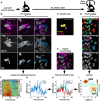Time-integrated BMP signaling determines fate in a stem cell model for early human development
- PMID: 38368368
- PMCID: PMC10874454
- DOI: 10.1038/s41467-024-45719-9
Time-integrated BMP signaling determines fate in a stem cell model for early human development
Abstract
How paracrine signals are interpreted to yield multiple cell fate decisions in a dynamic context during human development in vivo and in vitro remains poorly understood. Here we report an automated tracking method to follow signaling histories linked to cell fate in large numbers of human pluripotent stem cells (hPSCs). Using an unbiased statistical approach, we discover that measured BMP signaling history correlates strongly with fate in individual cells. We find that BMP response in hPSCs varies more strongly in the duration of signaling than the level. However, both the level and duration of signaling activity control cell fate choices only by changing the time integral. Therefore, signaling duration and level are interchangeable in this context. In a stem cell model for patterning of the human embryo, we show that signaling histories predict the fate pattern and that the integral model correctly predicts changes in cell fate domains when signaling is perturbed. Our data suggest that mechanistically, BMP signaling is integrated by SOX2.
© 2024. The Author(s).
Conflict of interest statement
The authors declare no competing interests.
Figures






Update of
-
The time integral of BMP signaling determines fate in a stem cell model for early human development.bioRxiv [Preprint]. 2023 Apr 10:2023.04.10.536068. doi: 10.1101/2023.04.10.536068. bioRxiv. 2023. Update in: Nat Commun. 2024 Feb 17;15(1):1471. doi: 10.1038/s41467-024-45719-9. PMID: 37090515 Free PMC article. Updated. Preprint.
Similar articles
-
The time integral of BMP signaling determines fate in a stem cell model for early human development.bioRxiv [Preprint]. 2023 Apr 10:2023.04.10.536068. doi: 10.1101/2023.04.10.536068. bioRxiv. 2023. Update in: Nat Commun. 2024 Feb 17;15(1):1471. doi: 10.1038/s41467-024-45719-9. PMID: 37090515 Free PMC article. Updated. Preprint.
-
Dissecting the dynamics of signaling events in the BMP, WNT, and NODAL cascade during self-organized fate patterning in human gastruloids.PLoS Biol. 2019 Oct 15;17(10):e3000498. doi: 10.1371/journal.pbio.3000498. eCollection 2019 Oct. PLoS Biol. 2019. PMID: 31613879 Free PMC article.
-
BMP-SMAD signaling: From pluripotent stem cells to cardiovascular commitment.Cytokine Growth Factor Rev. 2016 Feb;27:55-63. doi: 10.1016/j.cytogfr.2015.11.007. Epub 2015 Nov 24. Cytokine Growth Factor Rev. 2016. PMID: 26651597
-
Engineering the human pluripotent stem cell microenvironment to direct cell fate.Biotechnol Adv. 2013 Nov 15;31(7):1002-19. doi: 10.1016/j.biotechadv.2013.03.002. Epub 2013 Mar 17. Biotechnol Adv. 2013. PMID: 23510904 Free PMC article. Review.
-
Concise Review: Signaling Control of Early Fate Decisions Around the Human Pluripotent Stem Cell State.Stem Cells. 2017 Feb;35(2):277-283. doi: 10.1002/stem.2527. Epub 2016 Nov 10. Stem Cells. 2017. PMID: 27758015 Review.
Cited by
-
Extended culture of 2D gastruloids to model human mesoderm development.Nat Methods. 2025 Jun;22(6):1355-1365. doi: 10.1038/s41592-025-02669-4. Epub 2025 May 7. Nat Methods. 2025. PMID: 40335707
-
Timing and Graded BMP Signalling Determines Fate of Neural Crest and Ectodermal Placode Derivatives from Pluripotent Stem Cells.Biomedicines. 2024 Oct 4;12(10):2262. doi: 10.3390/biomedicines12102262. Biomedicines. 2024. PMID: 39457575 Free PMC article. Review.
-
The many dimensions of germline competence.Curr Opin Cell Biol. 2023 Dec;85:102259. doi: 10.1016/j.ceb.2023.102259. Epub 2023 Oct 16. Curr Opin Cell Biol. 2023. PMID: 37852152 Free PMC article. Review.
-
Reconstructing signaling history of single cells with imaging-based molecular recording.bioRxiv [Preprint]. 2024 Oct 12:2024.10.11.617908. doi: 10.1101/2024.10.11.617908. bioRxiv. 2024. PMID: 39416000 Free PMC article. Preprint.
-
HAND1 level controls the specification of multipotent cardiac and extraembryonic progenitors from human pluripotent stem cells.EMBO J. 2025 May;44(9):2541-2565. doi: 10.1038/s44318-025-00409-0. Epub 2025 Mar 31. EMBO J. 2025. PMID: 40164946 Free PMC article.
References
MeSH terms
Grants and funding
LinkOut - more resources
Full Text Sources
Molecular Biology Databases

